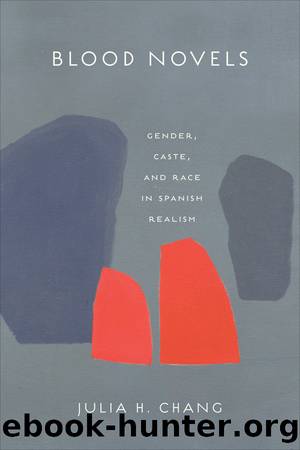Blood Novels by Julia H. Chang;

Author:Julia H. Chang;
Language: eng
Format: epub, pdf
Publisher: University of Toronto Press
The Aristocrat
Like the other protagonists studied in this book, Isidora fixates on her matrilineal inheritance: âmi madre ⦠fue hija de una marquesaâ (âmy mother ⦠was the daughter of a marquesaâ; La desheredada 110; Clark 48). In contrast to Doña Luz and La Regenta, however, La desheredada distorts the chastity bind, as Isidora has no real aristocratic bloodlines to speak of. If in the antiquated Vetusta, Ana Ozores was bound by early modern codes of blood purity and honour, Isidora, in a markedly modern Madrid, clings to a fantasy borne by novel reading (110). In La Regenta, Ana Ozoresâs reading is thought to prompt her early menstruation, while in La desheredada fiction reading further fuels Isidoraâs delusional attachment to blood. When Isidoraâs attempts to convince her aunt, La Sanguijuela, of her secret aristocratic origins, she retorts: âMe parece que tú te has hartado de leer esos librotes que llaman novelasâ (âIt seems to me youâve been reading too many of those fat books they call novelsâ; 110; 48). With both La Regenta and La desheredada, we see strong connections between the woman reader and the creation of blood fictions. In the case of the latter, aristocratic birthright appears outmoded in a modernizing world in which bloodlines have lost their lustre and social rank seems increasingly determined by taste and sartorial style.
For the purpose of my argument, I am interested in the fact that Isidora manoeuvres two distinct but coterminous modes of social identification: aristocratic birthright and bourgeois self-fashioning. Jo Labanyi rightfully notes that the narrator fuses Isidoraâs sense of birthright with the idea of merit: âWith Isidoraâs inheritance, Galdós is, of course, specifically dealing with the question of the aristocracy â i.e., the right to wealth and position by birth into a certain class. But it is worth noting that Isidora does not hinge her claim to an inheritance solely on her supposed noble birth; she considers that she merits a position in society, even if she is not entitled to it by rank, because of her innate qualities of beauty and taste: a âbirthright of meritâ rather than of classâ (âThe Political Significance of La desheredadaâ). Colin McKinney, for his part, has examined Isidoraâs identity quest through the Bourdieusian concept of distinction, which relies heavily on cultivation of taste. McKinney argues that Isidora navigates a âthin road between distinction and cursilerÃaâ (55). The latter leads Isidora into a cycle of poverty and prostitution, while the former, a seemingly anachronistic Cervantine fantasy, takes on the characteristics of a modern neurosis.
In âFamily Romance,â first published in 1908, Sigmund Freud writes that the âfreeing of the individual, as he grows up, from the authority of his parents is one of the most necessary though one of the most painful results brought about by the course of his developmentâ (156). Throughout this process, the child becomes increasingly aware of his once idealized parentsâ flaws, and in response he creates a âfantasy in which both parents are replaced by others of better birthâ (157).
Download
This site does not store any files on its server. We only index and link to content provided by other sites. Please contact the content providers to delete copyright contents if any and email us, we'll remove relevant links or contents immediately.
4 3 2 1: A Novel by Paul Auster(11788)
The handmaid's tale by Margaret Atwood(7447)
Giovanni's Room by James Baldwin(6808)
Asking the Right Questions: A Guide to Critical Thinking by M. Neil Browne & Stuart M. Keeley(5356)
Big Magic: Creative Living Beyond Fear by Elizabeth Gilbert(5351)
Ego Is the Enemy by Ryan Holiday(4956)
On Writing A Memoir of the Craft by Stephen King(4662)
The Body: A Guide for Occupants by Bill Bryson(4583)
Ken Follett - World without end by Ken Follett(4443)
Bluets by Maggie Nelson(4261)
Adulting by Kelly Williams Brown(4232)
Eat That Frog! by Brian Tracy(4149)
Guilty Pleasures by Laurell K Hamilton(4116)
White Noise - A Novel by Don DeLillo(3829)
The Poetry of Pablo Neruda by Pablo Neruda(3815)
Fingerprints of the Gods by Graham Hancock(3738)
Alive: The Story of the Andes Survivors by Piers Paul Read(3730)
The Book of Joy by Dalai Lama(3697)
The Bookshop by Penelope Fitzgerald(3619)
